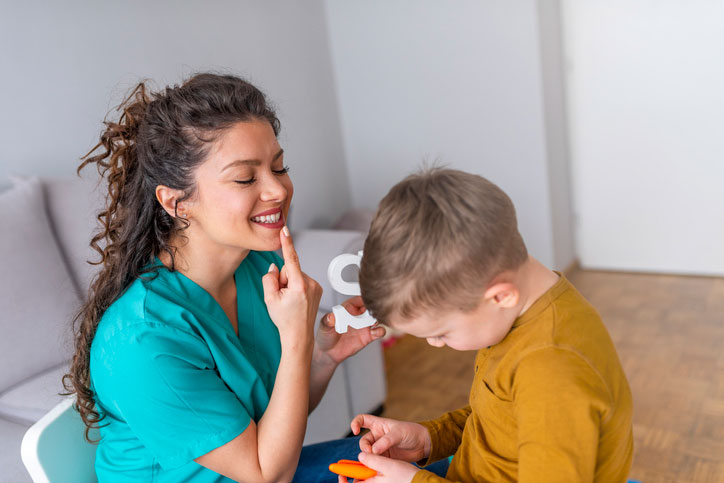As the world hit pause in early 2020 while the SARS-CoV-2 virus spread, one of the biggest impacts on many American families was the closing of local schools. Almost overnight, kids of all ages ended up out of the classroom and in their bedrooms, living rooms, and generally underfoot as desperate parents tried to juggle childcare with work and life routines that were being up-ended at the same time.
There was plenty of concern at the time that the sudden segregation of children in certain developmental stages would lead to long-term deficiencies in learning.
Now, speech-language pathologists (SLPs) and other developmental health professionals are starting to quantify and categorize the impacts of those closures.
In particular, standardized testing shows a delay in both developmental and educational test scores at various age levels from pre-pandemic baselines.
A Traditional Population for Speech Therapy Services With More Needs Than Ever
This is having an impact on speech-language pathology practice in a big way. A 2023 survey by ASHA, the American Speech-Language-Hearing Association, found that nearly 70 percent of SLPs were getting an increase in speech-language referrals over and above 2020 levels. The kids coming in have more emotional and behavioral issues, delayed language development, and social communication problems.
The primary reason for those referrals, the SLPs reported, was that those kids had limited opportunities for social interaction or play time with peers.
It’s too soon for researchers to say definitively that this was caused by the isolation brought on during COVID-19. It’s also going to take years of analysis to tease out whether the impact will be short-term or long-term, and what other factors might be in play. For example, for many kids, screen-time went through the roof during the pandemic, since in-person play time was off the menu. A group of researchers from Drexel recently found that toddlers with higher screen-viewing consumption were more likely to have atypical sensory-processing behaviors than their peers. Such secondary impacts could play a big role, too.
It’s also possible that stressors on caregivers during the pandemic may have decreased their responsiveness to early communication efforts from those children, delaying their development. And, of course, many normal screenings and other speech therapy treatment were put off as the healthcare system skidded along the edge of crisis.
But one thing right now is for sure: speech-language therapists who specialize in child language disorders are going to need to brace for impact as more kids come in the door needing treatment.
How To Prepare for the New Wave of Developmental Delays With an SLP Degree
 The best preparation for new challenges is always education.
The best preparation for new challenges is always education.
Plenty of SLP master’s degree programs already have a strong helping of courses, or even faculty who are specialized in, child language disorders or pediatric practice. These help lay the foundations for diagnosing and treating kids with developmental delays through a deeper understanding of human language development and speech processes.
In the right program, you’ll also be exposed to research in the field, possibly even into this specific issue. That’s always a winner for any future employers looking to hire SLPs to help treat the wave of issues.
You’ll probably also want to use your training to get familiar with the special processes and practices for working within school systems. That means understanding IDEA, the Individuals with Disabilities Education Act, and the specifics of the Individualized Education Plans (IEPs) that it requires for kids who have specialized educational needs.
Telemedicine and Virtual Reality Therapy is Making Treatment More Available
One big positive that came out of the pandemic in the speech therapy world was the sudden explosion of virtual treatment services. While this was seat-of-the-pants stuff during the lockdowns, and perhaps not as effective as it could have been, providers rapidly developed best practices. The overall availability and skill level of SLPs delivering service via telepractice is higher today than ever.
That isn’t as critical in today’s environment for treating kids, but it’s still a major benefit. Facing a larger population of children needing services, more efficient virtual visits can help SLPs reach every patient who needs them.
Naturally, your abilities to deliver effective virtual therapy will also reach back to your training. Anyone whose master’s program offered a course in, say, VR therapy, has a real leg up on offering these new services.
For that matter, although it’s not directly connected, getting your master’s in SLP in an online format probably helps you get more comfortable with online interaction and professional virtual practice in general.
Planning Your Education Around the Growing Demand for SLPs Specializing in Developmental Delays
 The real story here, however, is that the demand for SLPs, particularly in children’s services, is going up faster than degree programs are producing them.
The real story here, however, is that the demand for SLPs, particularly in children’s services, is going up faster than degree programs are producing them.
While that data is anecdotal, coming from practices who are being swamped by referrals, the overall trend is clear: the Bureau of Labor Statistics forecasts that the number of positions for SLPs in the ten-year period leading up to 2033 will increase by more than 33,000, an 18 percent rate of growth that is much faster than the average in the United States.
There’s no fast-track to getting the education you need to get into those jobs but understanding that there’s a wave of kids who are going to need services to help catch-up gives you something to aim at. Whatever stage you are in on your path to becoming licensed, you can look to the pandemic cohort for an idea of how you can mold your skills to serve them.
That might mean shifting your clinical fellowship over to a practice that specializes in children’s services today. It could mean taking electives in your master’s program that help you develop skills for middle and high school practice. Or you might be at the undergrad stage, and your best bet could be looking at how SLPs best serve individuals in early adulthood with long-term developmental speech delays.
With a wide array of both online and traditional CAA-Accredited graduate programs out there to choose from, you will be able to get the training you need to help these kids no matter where you are located. And since the pandemic itself was a global phenomenon, you can be sure that there are going to be demands for these specific services in your area, anywhere in the country.
- Emerson College - Master's in Speech-Language Pathology online - Prepare to become an SLP in as few as 20 months. No GRE required. Scholarships available.
- Arizona State University - Online - Online Bachelor of Science in Speech and Hearing Science - Designed to prepare graduates to work in behavioral health settings or transition to graduate programs in speech-language pathology and audiology.
- NYU Steinhardt - NYU Steinhardt's Master of Science in Communicative Sciences and Disorders online - ASHA-accredited. Bachelor's degree required. Graduate prepared to pursue licensure.
- Pepperdine University - Embark on a transformative professional and personal journey in the online Master of Science in Speech-Language Pathology program from Pepperdine University. Our program brings together rigorous academics, research-driven faculty teaching, and robust clinical experiences, all wrapped within our Christian mission to serve our communities and improve the lives of others.
